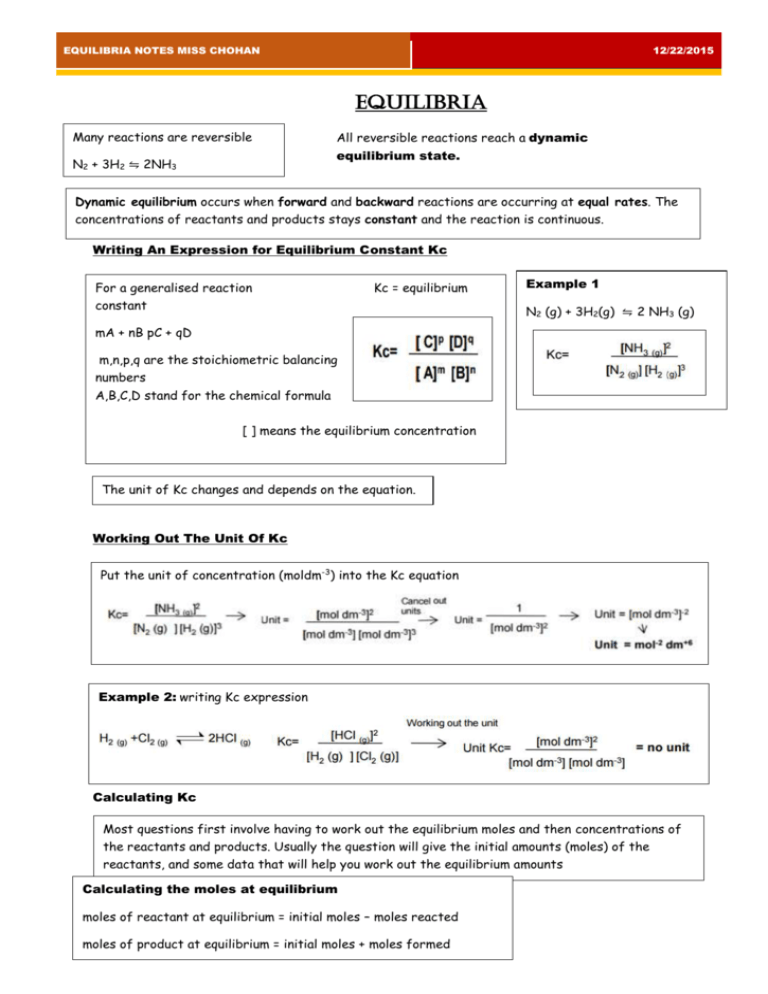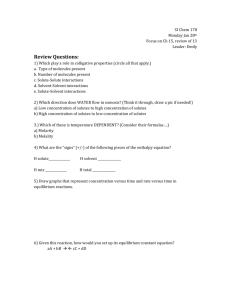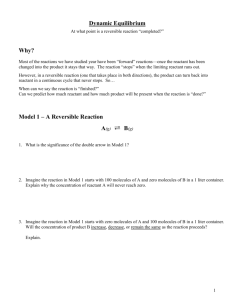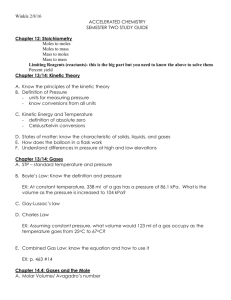File - chohan`s chemistry
advertisement

EQUILIBRIA NOTES MISS CHOHAN 12/22/2015 EQUILIBRIA Many reactions are reversible All reversible reactions reach a dynamic equilibrium state. N2 + 3H2 ⇋ 2NH3 Dynamic equilibrium occurs when forward and backward reactions are occurring at equal rates. The concentrations of reactants and products stays constant and the reaction is continuous. Writing An Expression for Equilibrium Constant Kc For a generalised reaction constant Kc = equilibrium Example 1 N2 (g) + 3H2(g) ⇋ 2 NH3 (g) mA + nB pC + qD m,n,p,q are the stoichiometric balancing numbers A,B,C,D stand for the chemical formula [ ] means the equilibrium concentration The unit of Kc changes and depends on the equation. Working Out The Unit Of Kc Put the unit of concentration (moldm-3) into the Kc equation Example 2: writing Kc expression Calculating Kc Most questions first involve having to work out the equilibrium moles and then concentrations of the reactants and products. Usually the question will give the initial amounts (moles) of the reactants, and some data that will help you work out the equilibrium amounts Calculating the moles at equilibrium moles of reactant at equilibrium = initial moles – moles reacted moles of product at equilibrium = initial moles + moles formed EQUILIBRIA NOTES MISS CHOHAN 12/22/2015 Example 3 For the following equilibrium H2 (g) +Cl2 (g) ⇌ 2HCl (g) In a container of volume 600cm3 there were initially 0.5mol of H2 and 0.6 mol of Cl2 . At equilibrium there were 0.2 moles of HCl. Calculate Kc It is often useful to put the mole data in a table Using the balanced equation if 0.2 moles of HCl has been formed it must have used up 0.1 of Cl2 and 0.1 moles of H2 (as 1:2 ratio) moles of reactant at equilibrium = initial moles – moles reacted moles of hydrogen at equilibrium = 0.5 – 0.1 = 0.4 moles of chlorine at equilibrium = 0.6 – 0.1 = 0.5 If the Kc has no unit then there are equal numbers of reactants and products. In this case you do not have to divide by volume to work out concentration and equilibrium moles could be put straight into the kc expression EQUILIBRIA NOTES MISS CHOHAN 12/22/2015 Example 4 For the following equilibrium N2 (g) + 3H2 (g) ⇌ 2 NH3 (g) Initially there were 1.5 moles of N2 and 4 moles of H2, in a 1.5 dm3 container. At equilibrium 30% of the Nitrogen had reacted. Calculate Kc 30% of the nitrogen had reacted = 0.3 x1.5 = 0.45 moles reacted. Using the balanced equation 3 x 0.45 moles of H2 must have reacted and 2x 0.45 moles of NH3 must have formed moles of reactant at equilibrium = initial moles – moles reacted moles of nitrogen at equilibrium = 1.5 – 0.45 = 1.05 moles of hydrogen at equilibrium =4.0 – 0.45 x3 = 2.65 moles of product at equilibrium = initial moles + moles formed moles of ammonia at equilibrium = 0 + (0.45 x 2) = 0.9 Finally put concentrations into Kc expression EQUILIBRIA NOTES MISS CHOHAN 12/22/2015 Partial Pressures and Kp If a reaction contains gases an alternative equilibrium expression can be set up using the partial pressures of the gases instead of concentrations Partial Pressure The partial pressure of a gas in a mixture is the pressure that the gas would have if it alone occupied the volume occupied by the whole mixture. partial pressure = mole fraction x total pressure of gas 1 If a mixture of gases contains 3 different gases then the total pressure will equal the 3 partial pressure added together P =p1 + p2 + p3 Mole Fraction Example : A mixture contains 0.2 moles N2, 0.5 moles O2 and 1.2 moles of CO2. If the total pressure is 3atm. What are the partial pressures of the 3 gases? Writing An Expression for Kp p means the partial pressure of that gas Kp = equilibrium constant Only include gases in the Kp expression. Ignore solids, liquids, and aqueous substances. EQUILIBRIA NOTES MISS CHOHAN 12/22/2015 Working Out The Unit of Kp Put the unit of pressure(atm) into the Kp equation However, if the equation is written the other way round, the value of Kp will be the inverse of above and the units will be atm2 . It is important therefore to write an equation when quoting values of Kp. Example 4 For the following equilibrium N2 (g) + 3H2 (g) ⇌ 2 NH3 (g) 1 mole of N2 and 3 moles of H2 are added together and the mixture is allowed to reach equilibrium. At equilibrium 20% of the N2 has reacted. If the total pressure is 2atm what is the value of Kp? 20% of the nitrogen had reacted = 0.2 x1.0 = 0.2 moles reacted. Using the balanced equation 3 x 0.2 moles of H2 must have reacted and 2x 0.2 moles of NH3 must have formed moles of reactant at equilibrium = initial moles – moles reacted moles of nitrogen at equilibrium = 1.0 – 0.2 = 0.8 moles of hydrogen at equilibrium =3.0 – 0.20 x3 = 2.40 moles of product at equilibrium = initial moles + moles formed moles of ammonia at equilibrium = 0 + (0.2 x 2) = 0.4 Finally put concentrations into Kp expression EQUILIBRIA NOTES MISS CHOHAN 12/22/2015 Heterogeneous Equilibria For Kp Kp expressions only contain gaseous substances. Any substance with another state is left out CaCO3 (s) ⇌ CaO (s) + CO2 (g) Kp =p CO2 Unit atm Equilibrium constants and feasibility Values of equilibrium constants can all be used to predict the extent a reaction might occur ΔStotal increases the magnitude of the equilibrium constant increases since ΔS = R lnK Where K is equilibrium constant Kc or Kp This equation shows a reaction with a Kc >1 will therefore have a positive ΔStotal Application Of Rates And Equilibrium Effect of changing conditions on value of Kc or Kp The larger the Kc the greater the amount of products. If Kc is small we say the equilibrium favours the reactants Kc and Kp only change with temperature. It does not change if pressure or concentration is altered. A catalyst also has no effect on Kc or Kp Effect of Temperature on position of equilibrium and Kc Both the position of equilibrium and the value of Kc or Kp will change it temperature is altered In this equilibrium which is exothermic in the forward direction N2 (g) + 3H2 (g) ⇌ 2 NH3 (g) If temperature is increased the reaction will shift to oppose the change and move in the backwards endothermic direction. The position of equilibrium shifts left. The value of Kc gets smaller as there are fewer products. EQUILIBRIA NOTES MISS CHOHAN 12/22/2015 Effect of Temperature on Rate As the temperature increases a significantly bigger proportion of particles have energy greater than the activation energy, so the frequency of successful collisions increases Effect of Concentration on Position of Equilibrium and Kc Changing concentration would shift the position of equilibrium but the value of Kc would not change. H2 (g) +Cl2 (g) ⇌ 2HCl (g) Increasing concentration of H2 would move equilibrium to the right lowering concentration of H2 and Cl2 and increasing concentration of HCl. The new concentrations would restore the equilibrium to the same value of Kc Effect of Concentration and Pressure on Rate At higher concentrations (and pressures) there are more particles per unit volume and so the particles collide with a greater frequency and there will be a higher frequency of effective collisions. Effect of Pressure on position of equilibrium and Kp The position of equilibrium will change it pressure is altered but the value of Kp stays constant as Kp only varies with temperature In this equilibrium which has fewer moles of gas on the product side N2 (g) + 3H2 (g) ⇌ 2 NH3 (g) If pressure is increased the reaction will shift to oppose the change and move in the forward direction to the side Increasing pressure does not change Kp. The increased pressure increases the pressure terms on bottom of Kp expression more than the top. The system is now no longer in equilibrium so the equilibrium shifts to the right increasing mole fractions of products and decreases the mole fractions of reactants. The top of Kp expression therefore increases and the bottom decreases until the original value of Kp is restored with fewer moles of gas. The position of equilibrium shifts right. The value of Kp stays the same though as only temperature changes the value of Kp. EQUILIBRIA NOTES MISS CHOHAN 12/22/2015 Effect of Catalysts on Position of Equilibrium and Kc A catalyst has no effect on the position of equilibrium or values of Kc and Kp, but it will speed up the rate at which the equilibrium is achieved. It does not effect the position of equilibrium because it speeds up the rates of the forward and backward reactions by the same amount. Catalysts speeds up the rate allowing lower temperatures to be used (and hence lower energy costs) but have no effect on equilibrium. Environmental benefits of Catalysts Catalysed reactions can occur at lower temperature so less fuel needed and fewer emissions from fuels. Catalysed reaction enables use of an alternative process with higher atom economy so meaning fewer raw materials needed and less waste products are produced Heterogeneous catalysis Adsorption of reactants at active sites on the surface may lead to catalytic action. A heterogeneous catalyst is in a different phase from the reactants The active site is the place where the reactants adsorb on to the surface of the catalyst. This can result in the bonds within Heterogeneous catalysts are usually solids whereas the reactants are gaseous or in solution. The the reactant molecules becoming weaker, or the molecules being held in a more reactive configuration. There will also be a higher reaction occurs at the surface of the catalyst. concentration of reactants at the solid surface so leading to a higher collision frequency Effect of Pressure on Heterogenous Catalysis. Increasing pressure has limited effect on the rate of heterogenous catalysed reactions because the reaction takes place on surface of the catalyst. The active sites on the catalyst surface are already saturated with reactant molecules so increasing pressure won’t have an effect Importance of Equilibrium To Industrial Processes Common examples Contact process Haber process N2 + 3H2 ⇌ 2NH3 Stage 1 S (s) + O2 (g) ⇌ SO2 (g) ∆H = -ve exo T= 450oC, P= 200 – 1000 atm, catalyst = iron Low temp gives good yield but slow rate: compromise temp used High pressure gives good yield and high rate: too high a pressure would lead to too high energy costs for pumps to produce the pressure Stage 2 SO2 (g) + ½ O2 (g) ⇌ SO3 (g) ∆H = -98 kJ mol-1 T= 450oC, P= 10 atm, catalyst = V2O5 Low temp gives good yield but slow rate: compromise moderate temp used High pressure gives slightly better yield and high rate: too high a pressure would lead to too high energy costs for pumps to produce the pressure EQUILIBRIA NOTES MISS CHOHAN 12/22/2015 In all cases high pressure leads to too high energy costs for pumps to produce the pressure and too high equipment costs to have equipment that can withstand high pressures. Recycling unreacted reactants back into the reactor can improve the overall yields of all these processes and improve their atom economy Industrial processes cannot be in equilibrium since the products are removed as they are formed to improve conversion of reactants. They are not closed systems EQUILIBRIA NOTES MISS CHOHAN 12/22/2015






